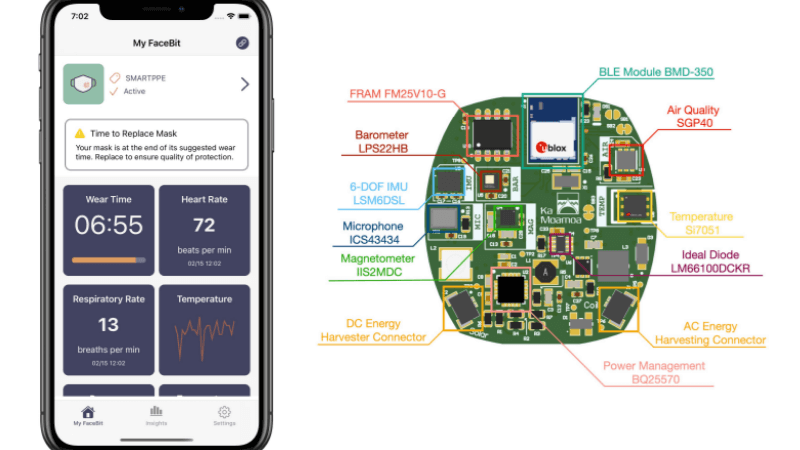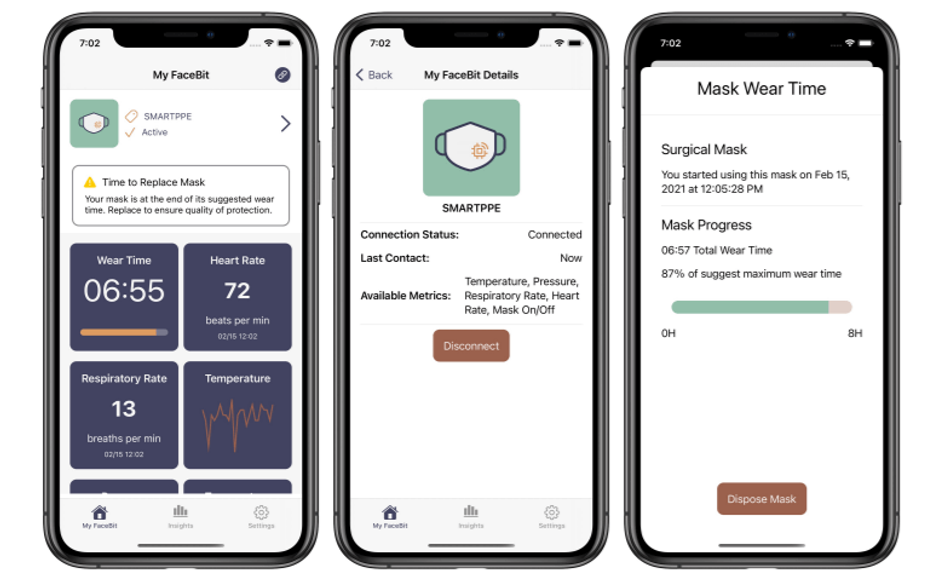Smart Face Mask Platform in Response to COVID-19 Pandemic
FaceBit aims to be low-cost, energy-efficient, and easy-to-integrate hardware with rich sensing functionalities– monitors physiological signals

FaceBit Smart Face Mask Platform
Mutations in the virus have given birth to multiple research streams for the treatment of viral infection. COVID-19 caused because of the SARS-CoV-2 virus, has changed the daily routine of human life– making it more conscious to protect itself from the global pandemic. Most of the day-to-day safety protocols in place are in the form of passive devices; limit the scope of improvement and cannot alert the user for potential risk. Wearing masks has been the most used protection against the SARS-CoV-2 virus infection– but lacks the technology to signal the user for mask degradation of improper fit. The innovation towards building smart devices that are scalable, lightweight and energy-efficient has been on the rise after realizing the need for active devices.
In the space of the maker community, there have been efforts in designing hardware platforms that can extract physiological signals from facial sensing points. Smart glasses [2] for measuring the heart rate to smart filter [3] for PPE to monitor the air filter quality in the detection of COVID-19 have played a significant role in wearable physiological sensing. Most of these solutions lacked scalability and on-device computing capabilities– in response to the COVID-19 spread. All these resource-constrained computing platforms and software/hardware ecosystem helped the researchers to develop an efficient and user-friendly smart device.
A team of researchers from Northwestern University, Georgia Institute of Technology, and the University of California at Los Angeles have proposed an open-source hardware platform for smart face mask applications. The increasing new highs of COVID-19 positive cases due to new infectious variants, and analyzing the slow global vaccination rate along– make this smart hardware platform a way to keep monitoring health parameters. Thanks to edge computing and AI inference advancements, the smart face masks platform creates a new research area for developing sustainable and convenient forms of health management, even for the COVID-19 pandemic.
What is FaceBit?
In the paper, “FaceBit: Smart Face Masks Platform”, the team proposes the design of a hardware and software ecosystem consisting of FaceBit circuit board along with a custom-built mobile application that can provide data collection, visualization and alert. Along with alertness, the hardware interacts with physiological changes– monitoring heart rate (through FaceBeat algorithm) without skin contact via ballistocardiography and respiration rate through temperature changes. Additionally, the hardware also checks the mask fitting and wear time from pressure signals; leveraging the always on-device with an energy-efficient system. All the data collected from the onboard sensors are wirelessly transmitted to the custom phone application for analysis.
Scaling such a product involves several factors that are to be considered– FaceBit aims to be low cost, energy-efficient and easy-to-integrate hardware with rich sensing functionalities. The hardware offers harvesting energy from breathing, motion and sunlight to supplement the tiny primary cell battery that alone delivers a battery lifetime of 11 days or more. With the help of a small magnet, the tiny form factor device fits on top of your existing masks without any modification. Moreover, the inclusion of a flexible interface has made it more convenient for the users to monitor the health parameters and keep track of the COVID-19 infection risk.

The FaceBit block diagram shows the essential parts that make up the whole ecosystem consisting of three energy sources– solar, thermal and battery, while three wireless sensors (temperature sensor, IMU and pressure sensor) for monitoring physiological signals. All the incoming data from the remote sensors is then digitally processed and categorized under respiratory rate, heart rate and mask fitting. Wirelessly sent to user-controlled mobile applications to complete the design flow of the hardware/software smart mask platform.
On the other side of the hardware platform is the FaceBit Companion application for phones and desktops that interacts with the FaceBit circuit board via Bluetooth Low Energy using a custom GATT profile. Built on iOS and macOS using Swift Programming Language, the user interface is written within the SwiftUI framework and uses Mac Catalyst that supports iOS applications deployed on macOS. “The application handles both high-frequency time-series data streams for debugging, as well as low frequency computed metrics from the sensor board for actual deployment,” the researchers explain. “The vision is that a user will be able to customize the home screen with desired widgets to receive timely information on the signals of interest.”

For future studies, the developers aim to optimize the signal pipeline to tune the FaceBeat algorithm to reduce the number of falsely detected heart rates. A battery-free system is something that can improve the sustainability of the device by integrating low-power modules like Ambiq Apollo3. As an open-source contribution, the innovators encourage the community to modify the hardware and software to bring more functionalities– available at facebit.health.
Reference
[1] Alexander Curtiss, Blaine Rothrock, Abu Bakar, Nivedita Arora, Jason Huang, Zachary Englhardt, Aaron-Patrick Empedrado, Chixiang Wang, Saad Ahmed, Yang Zhang, Nabil Alshurafa, and Josiah Hester. 2022. FaceBit: Smart Face Masks Platform. Proc. ACM Interact. Mob. Wearable Ubiquitous Technol. 5, 4, Article 151 (Dec 2021), 44 pages. DOI: https://doi.org/10.1145/3494991
[2] Hernandez, Javier et al. "Wearable Motion-Based Heart Rate at Rest: A Workplace Evaluation." IEEE Journal of Biomedical and Health Informatics 23, 5 (September 2019): 1920 - 1927
[3] Lut, J.-J. & Goddijn, M. Smart Personal Protective Equipment: Sensing and Control: The Future of Face Masks (Delft University of Technology, Delft, 2020).
